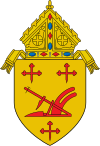St. Augustine Church was a Roman Catholic church located at 923 Bank Street near Ailanthus Street in the old West End of Cincinnati, Ohio. The Parish patron was St. Augustine of Hippo.
The parent parish was the English-speaking congregation, Saint Peter in Chains Cathedral. St. Augustine's was organized in 1852 for an English congregation. The cornerstone of the church was laid August 25, 1852, and the dedication took place October 16, 1853. Opposite the church was a large school and parsonage. A residence for the teaching brothers of Mary was situated on nearby Dayton Street.[1]
On June 14, 1857, however, a German congregation bought the church to serve its growing numbers. The church was enlarged by the Germans and rededicated November 13, 1859. In the late 19th century it was one of the largest of the German Catholic parishes in the United States, numbering 900 families in 1896.
The Parish was closed in 1978. Records for this Parish are located at St. Joseph Church, West End.
References
[edit]- ^ "Greater Cincinnati Memory Project". memory.gclc-lib.org. Archived from the original on 28 September 2007. Retrieved 13 January 2022.
External links
[edit]- Parish Profile
- St. Augustine Church
- St. Augustine Church and Rev. Walburg, circa 1909
- St. Augustine Church and St. Vincent Home for Boys, circa 1912



Well, that’s interesting to know that Psilotum nudum are known as whisk ferns. Psilotum nudum is the commoner species of the two. While the P. flaccidum is a rare species and is found in the tropical islands. Both the species are usually epiphytic in habit and grow upon tree ferns. These species may also be terrestrial and grow in humus or in the crevices of the rocks.
View the detailed Guide of Psilotum nudum: Detailed Study Of Psilotum Nudum (Whisk Fern), Classification, Anatomy, Reproduction